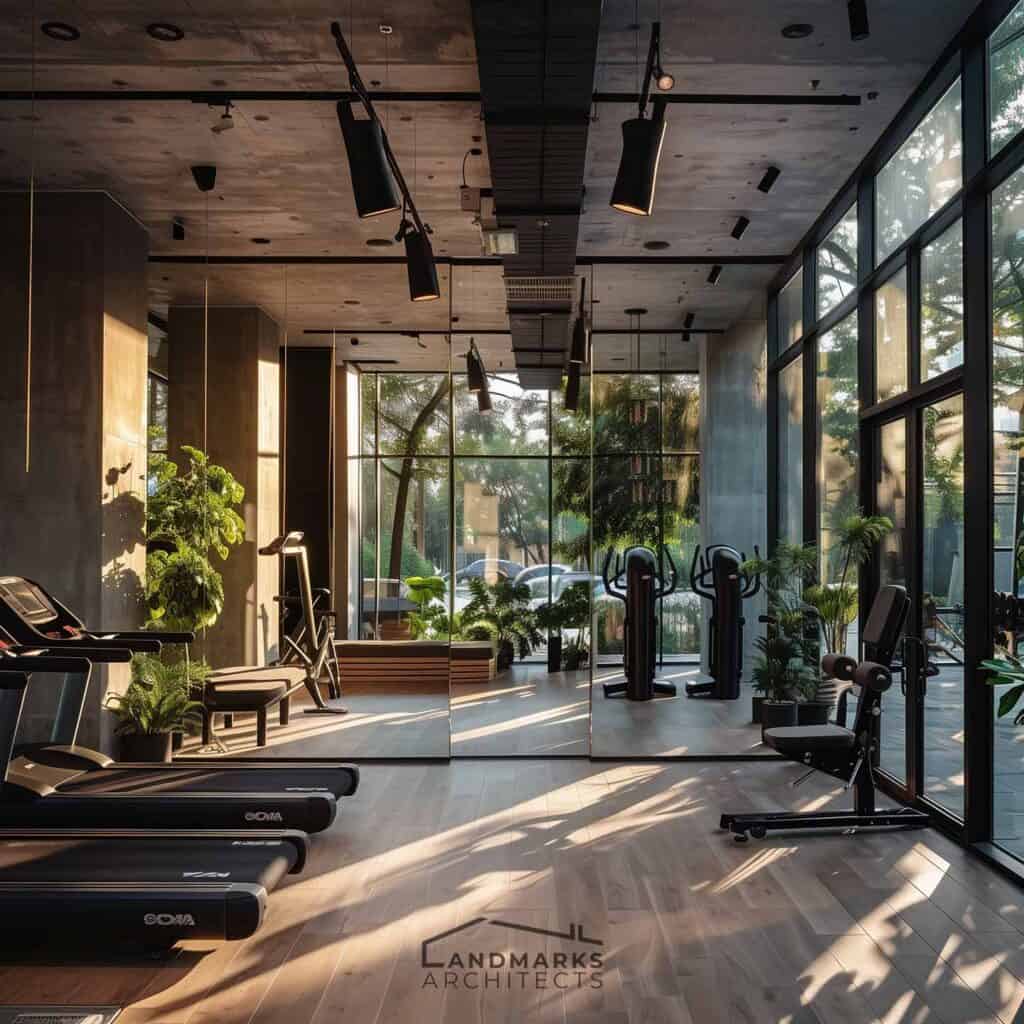
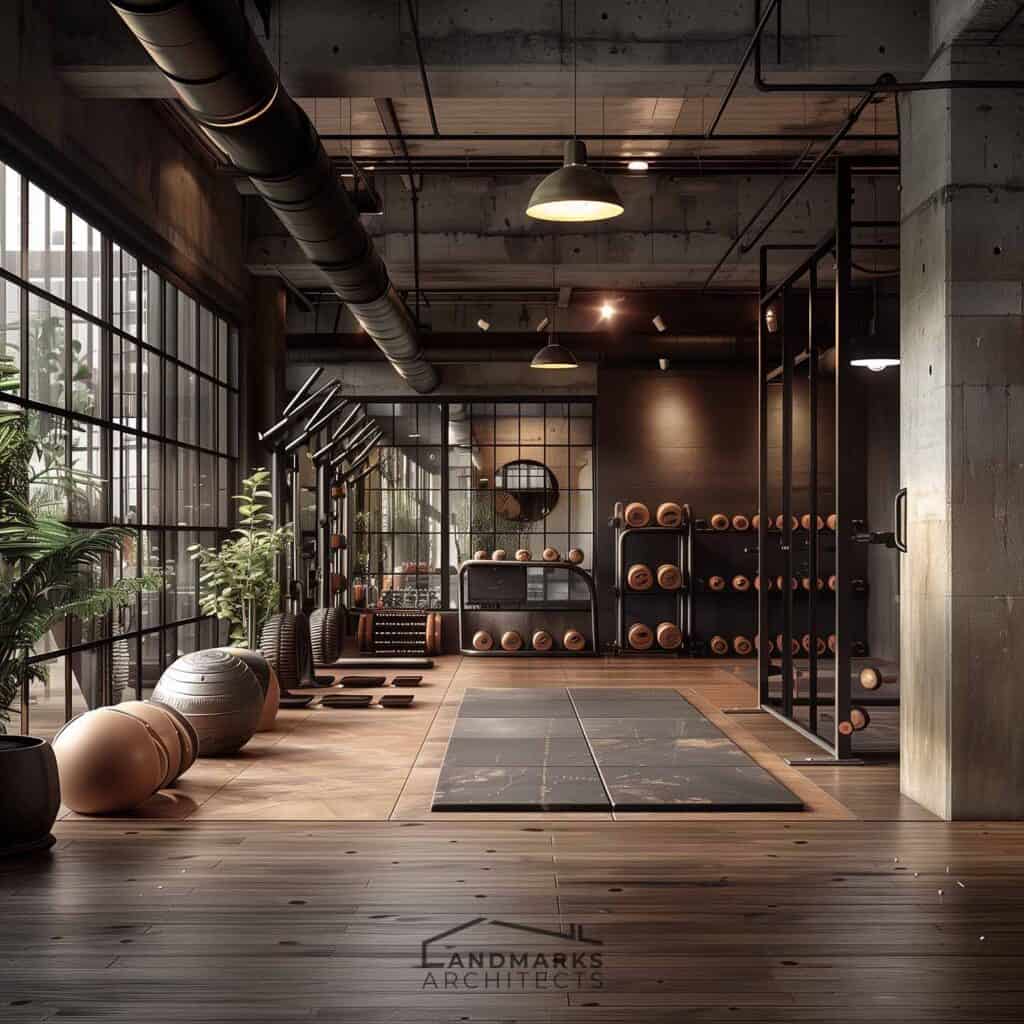
Welcome to a site, where fitness intertwines with design, ushering in a fresh era of gym interiors meticulously tailored to enhance the overall experience of gym-goers.
In this article, we’ll explore the world of gym interior design ideas, uncovering innovative concepts, practical solutions, and emerging trends. These elements are reshaping traditional fitness centers into spaces that prioritize holistic well-being and inspire gym-goers.
1. Functionality and Space Planning
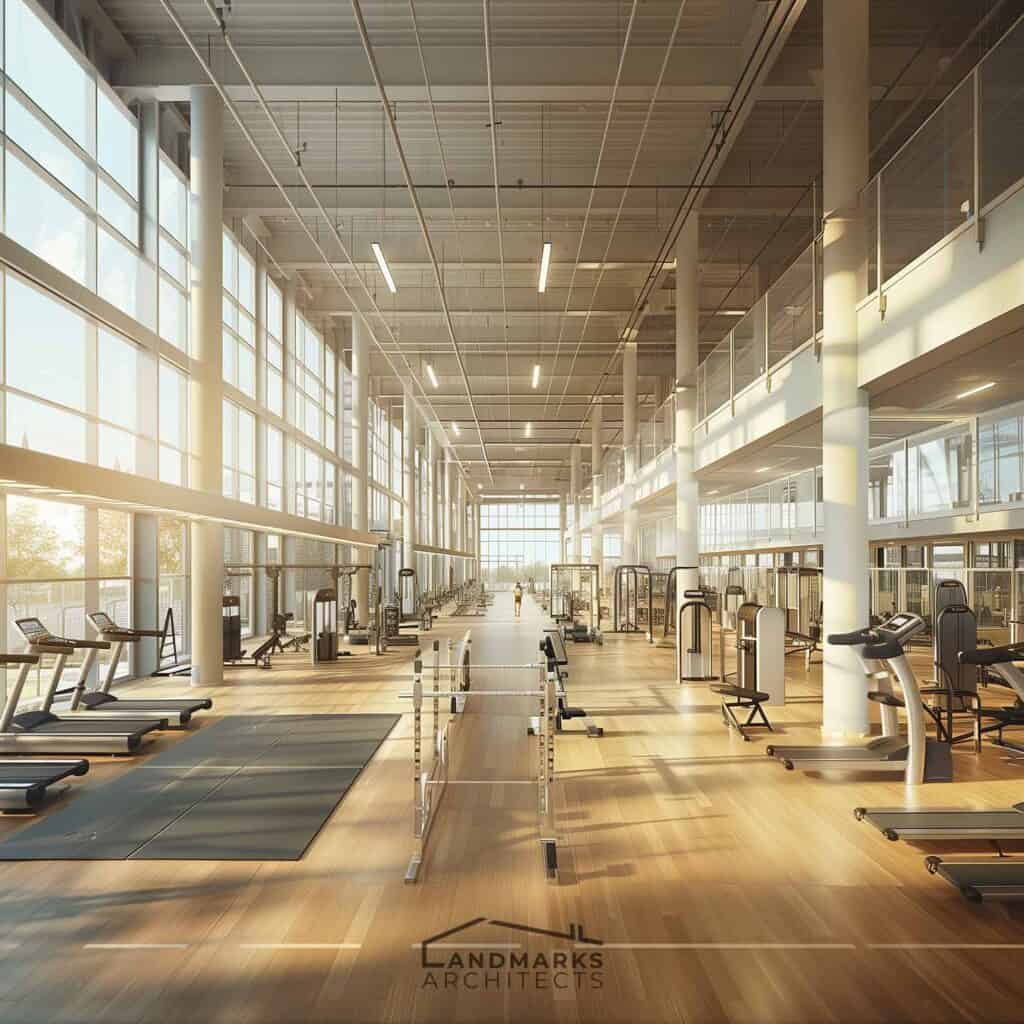
At the heart of every well-designed gym lies a foundation of functionality and efficient space planning. It’s not just about cramming equipment into a room. From the strategic arrangement of cardio and strength training zones to the seamless integration of circulation paths and workout stations, the art of space planning transforms the gym into a dynamic environment that caters to the varied needs of its users.
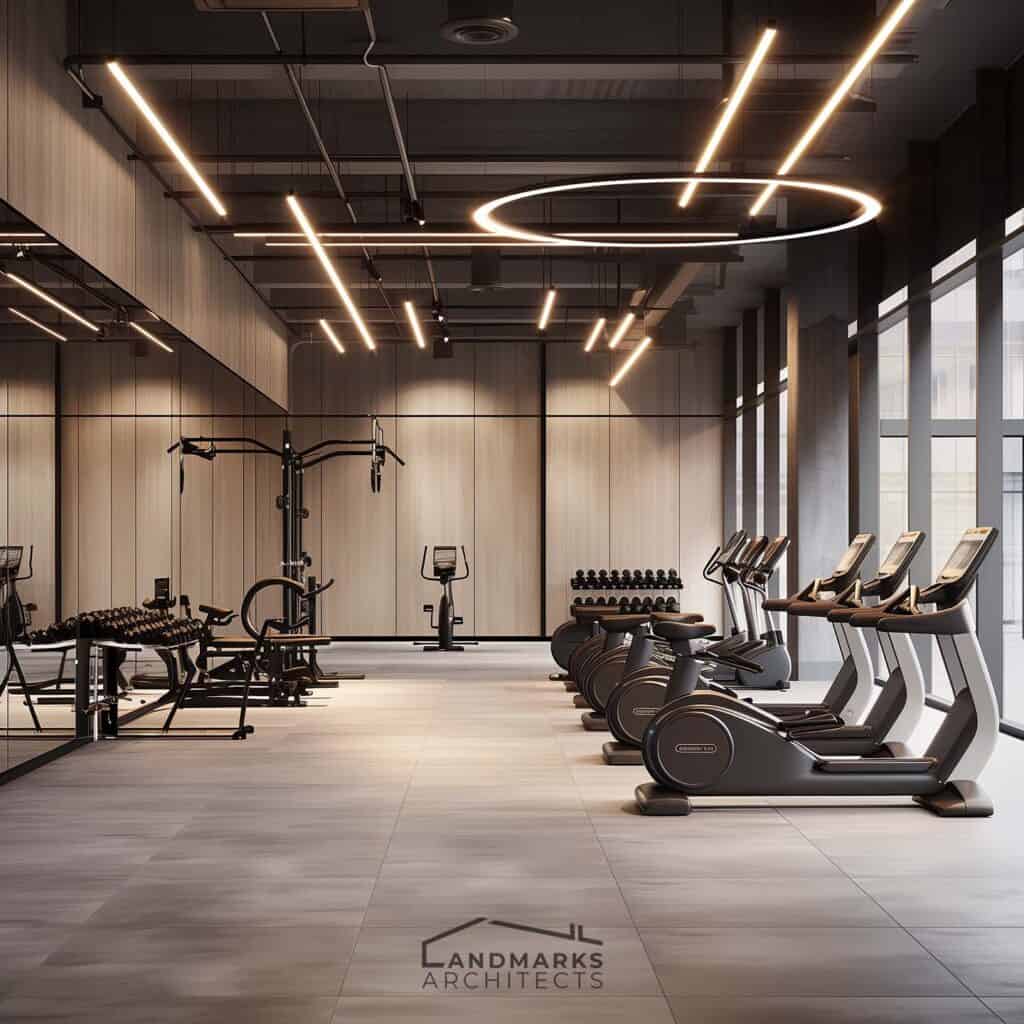
When designing gym spaces, it’s crucial to consider more than just the layout. Zoning for various workout activities becomes paramount, ensuring each area serves a specific purpose. For example, cardio sections might include lively zones for spinning classes and quieter corners for treadmill sessions. Functional gym design solutions, like modular equipment setups and adaptable floor plans, amplify flexibility. These features enable gyms to effortlessly conform to shifting fitness trends and evolving user preferences.
2. Aesthetic Elements
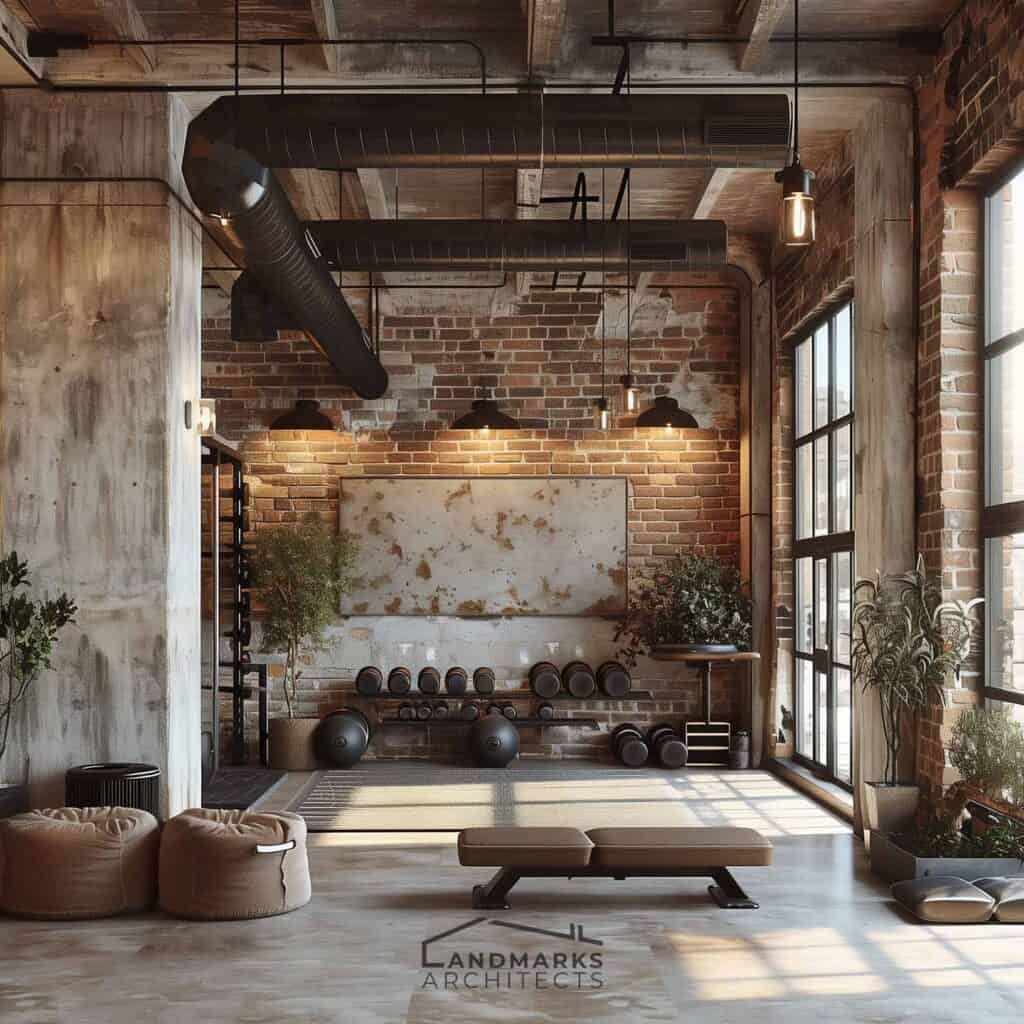
In gym interior design concept, spaces transcend mere functionality, becoming platforms for artistic expression that evoke emotions and ignite motivation through aesthetic elements. Here, the design possibilities are as varied as the individuals who inhabit these environments. From the raw, industrial allure of exposed brick walls and metal accents to the tranquil minimalism of sleek lines and neutral palettes, gym interiors offer a spectrum of design styles to captivate and inspire.
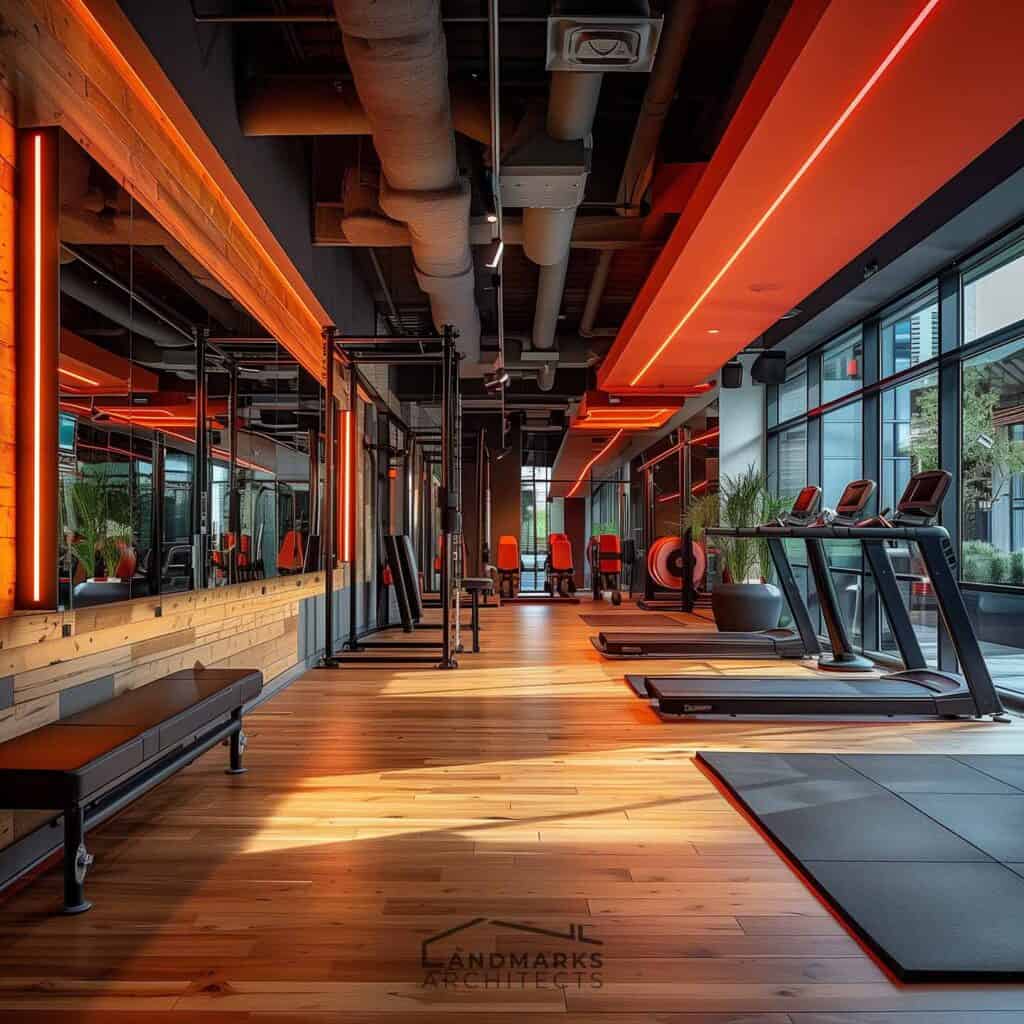
Colors, materials, and textures play instrumental roles in shaping the ambiance of a gym, creating atmospheres that energize, soothe, or invigorate. Dynamic hues inject bursts of energy into workout spaces, while natural elements like wood and stone bring a sense of grounding and connection to the earth. Texture-rich surfaces, from sleek glass panels to rugged rubber flooring, stimulate the senses, inviting exploration and engagement with the environment.
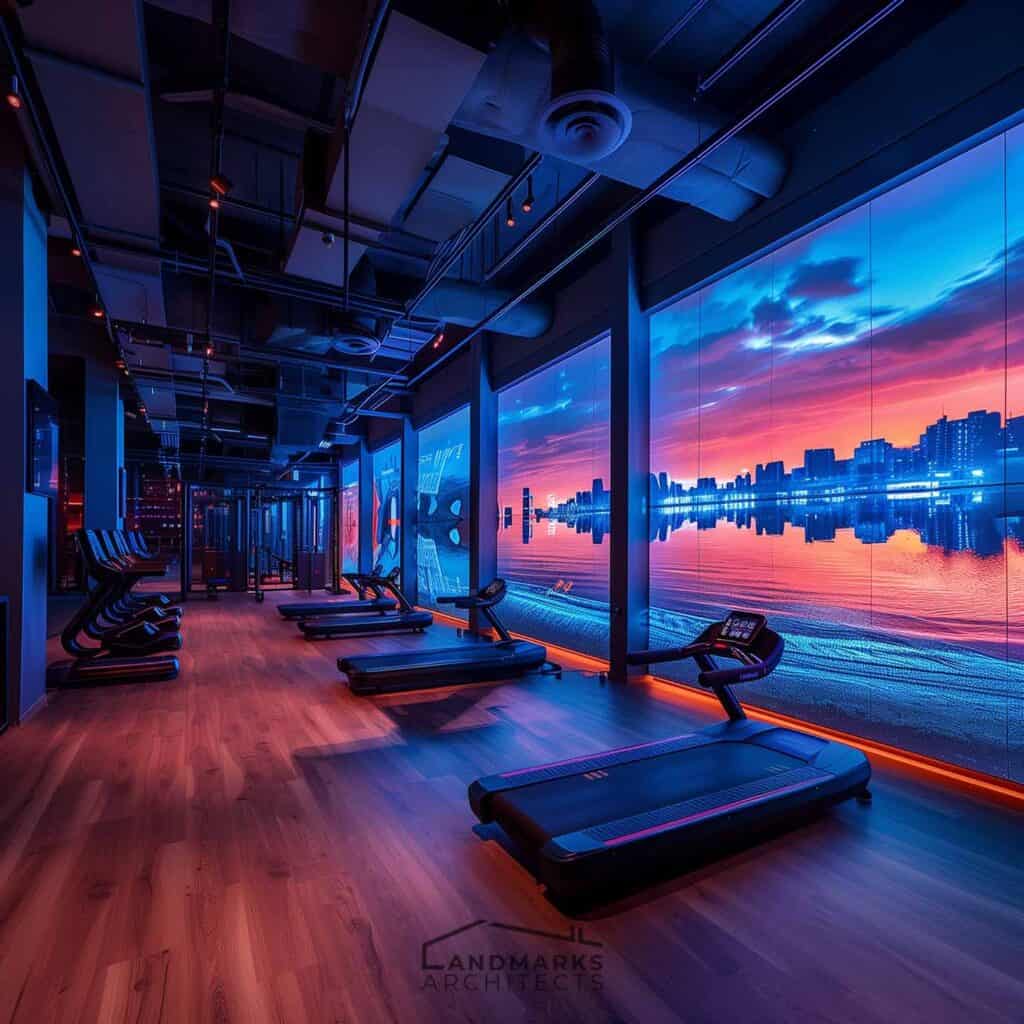
Cutting-edge design features not only enhance the aesthetic allure of gym space but also push beyond the confines of conventional gym layout. Digital displays whisk users away to virtual landscapes, while interactive installations react to movement and touch, transforming workouts into immersive, multisensory experiences. These state-of-the-art elements enchant the imagination and cultivate a profound connection between the body, mind, and space within the gym.
3. Lighting and Acoustics
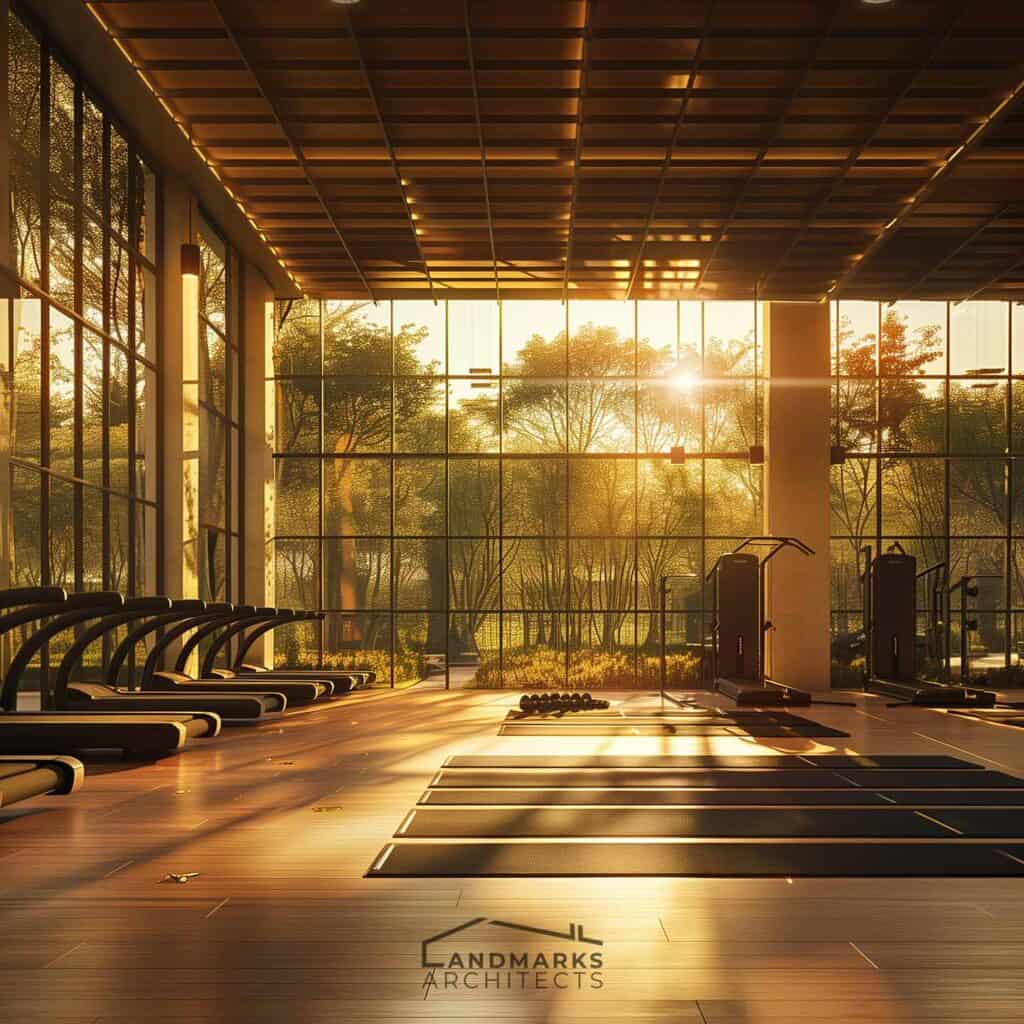
Lighting and acoustics play crucial roles in shaping the mood and atmosphere of a gym. Natural light floods in through expansive windows, infusing the environment with warmth and vitality while connecting users to the rhythms of the outside world.
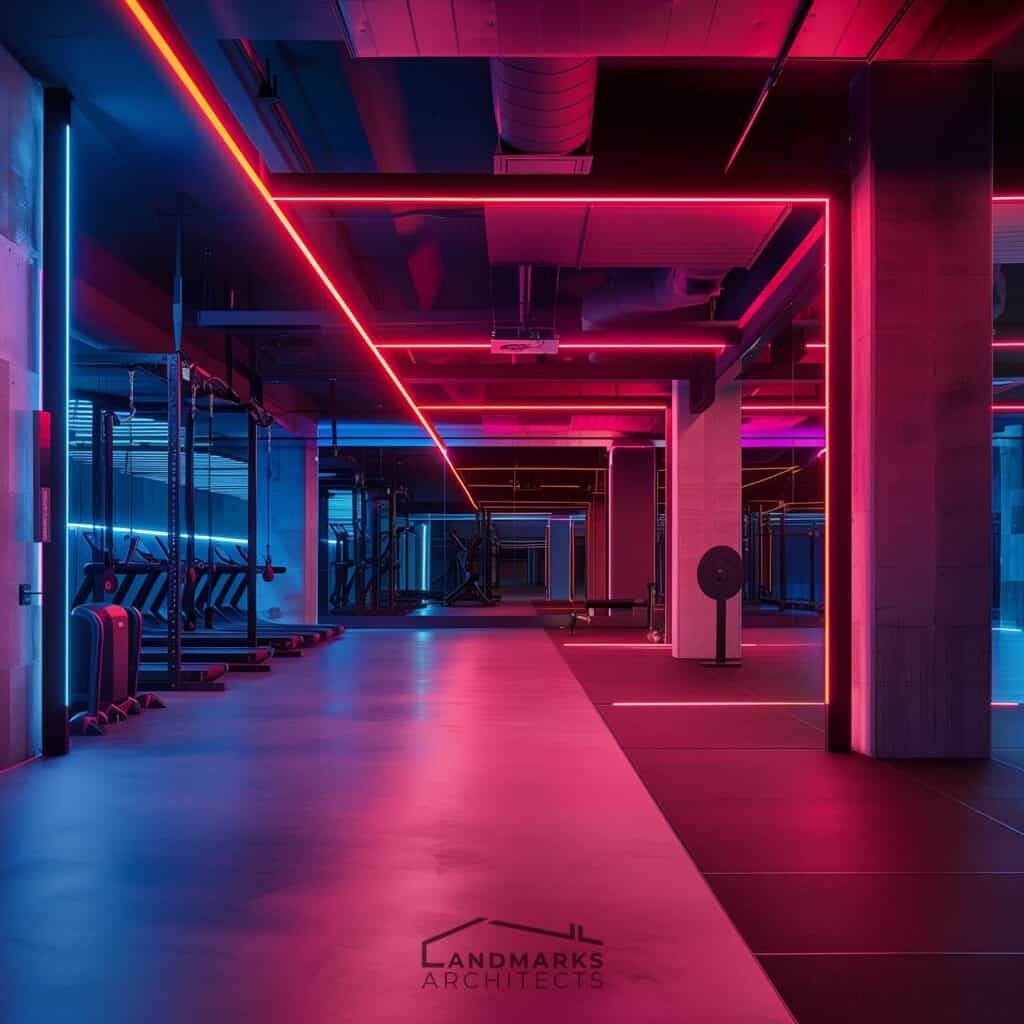
Artificial lighting takes center stage during evening workouts, illuminating focal points and creating dramatic contrasts that heighten the sensory experience. From dynamic LED fixtures that change color with the beat of the music to task lighting that highlights specific workout areas, lighting design transforms the gym into a stage where every movement is spotlighted and celebrated.

Acoustics play an equally vital role in shaping the auditory landscape of the gym, mitigating noise levels, and creating an environment conducive to focus and concentration. Sound-absorbing materials dampen echoes and reverberations, ensuring clarity of communication and minimizing distractions during group classes or personal training sessions. Thoughtfully curated playlists and state-of-the-art sound systems further enhance the auditory experience, synchronizing beats with heartbeats and amplifying the energy of every workout.
4. Design Ideas of Different Parts of the Gym
Entrance and Reception Area
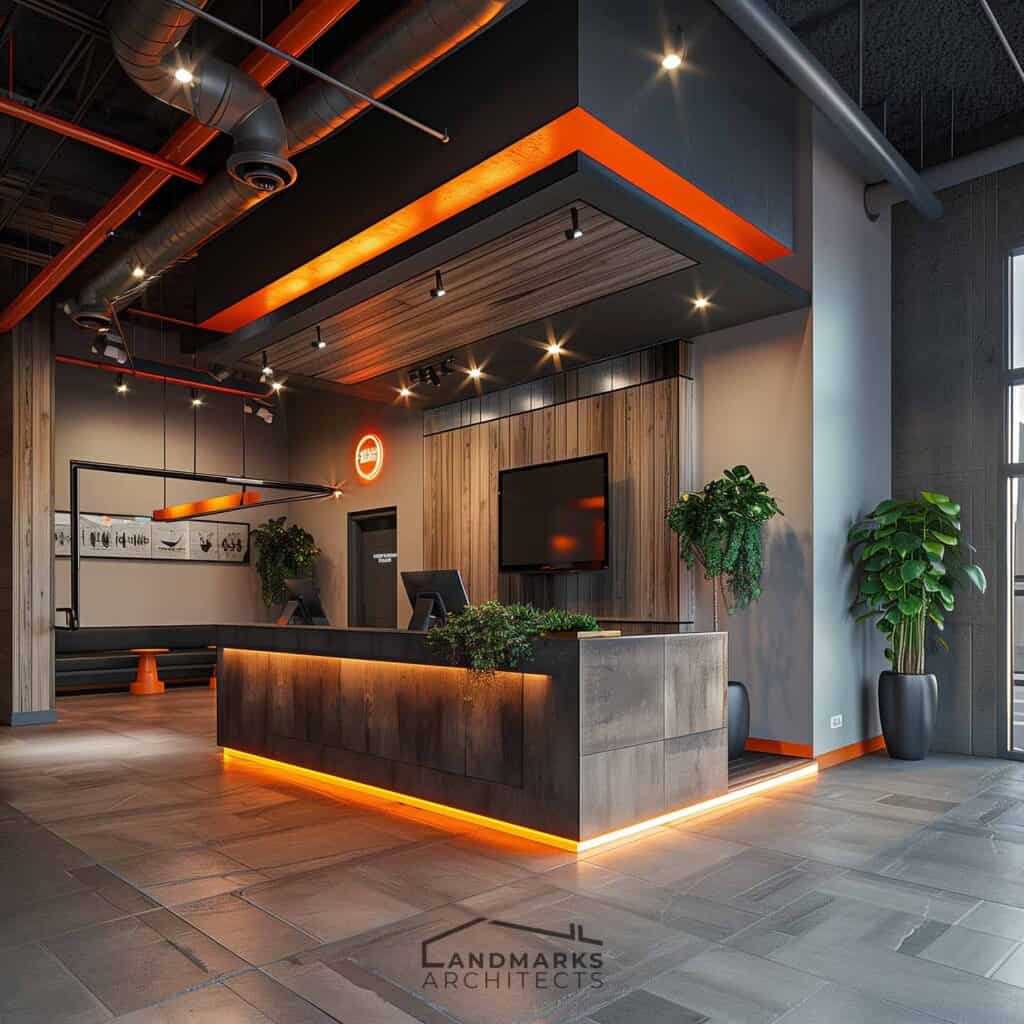
The entrance and reception area serve as the gateway to the gym experience, setting the stage for what lies beyond. Welcoming design elements, from sleek architectural details to lively accent colors, create a sense of anticipation and excitement, inviting visitors to commence their fitness adventure with confidence and enthusiasm.
Branding elements such as logos, signage, and color schemes reinforce brand identity and create a cohesive visual identity that extends throughout the space. Every detail, from the design of the reception desk to the layout of the waiting area, is carefully curated to enhance the customer experience and streamline the check-in process.
Sports Area
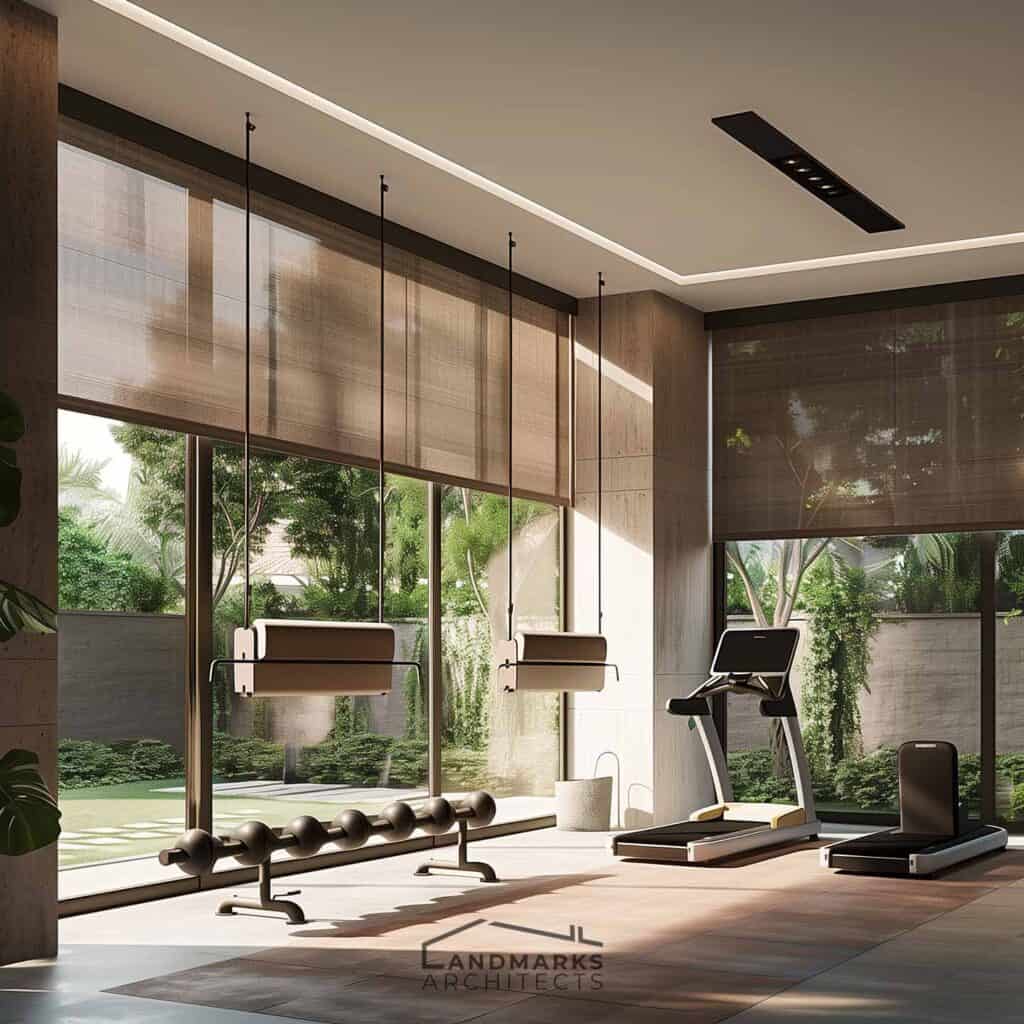
The sports area stands as the core of the gym, where users come together to challenge their bodies and minds in pursuit of their fitness goals. Thoughtfully designed layouts, ergonomic equipment arrangements, and versatile training zones create dynamic environments that cater to the diverse needs of users, from cardio enthusiasts to strength training aficionados.
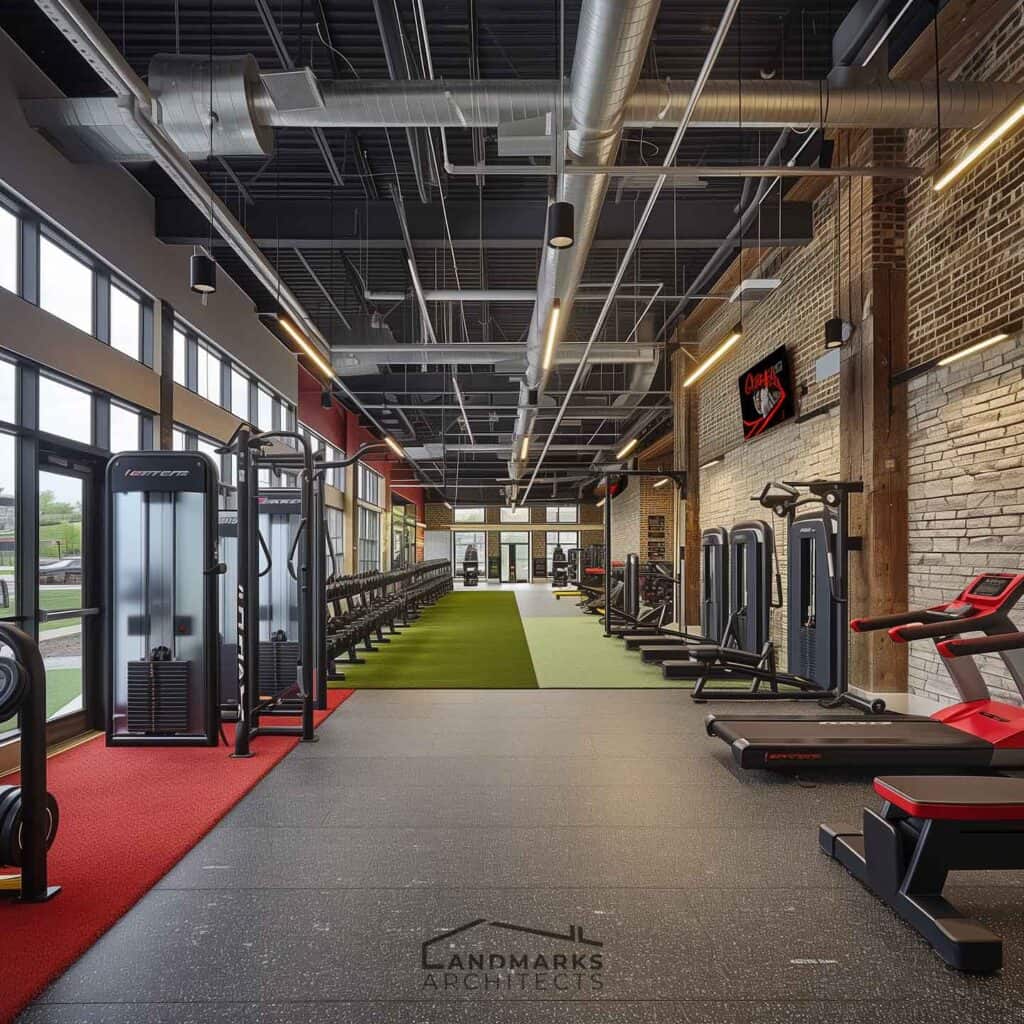
In gym design, zoning strategies are crucial for organizing workout spaces and facilitating smooth transitions between different types of exercises. Various areas are designated for specific purposes, ensuring users can easily navigate between them. For instance, cardio zones feature energetic music and dynamic lighting, while functional training areas are equipped with versatile gym equipment and spacious floors, fostering concentration, motivation, and a sense of community among users.
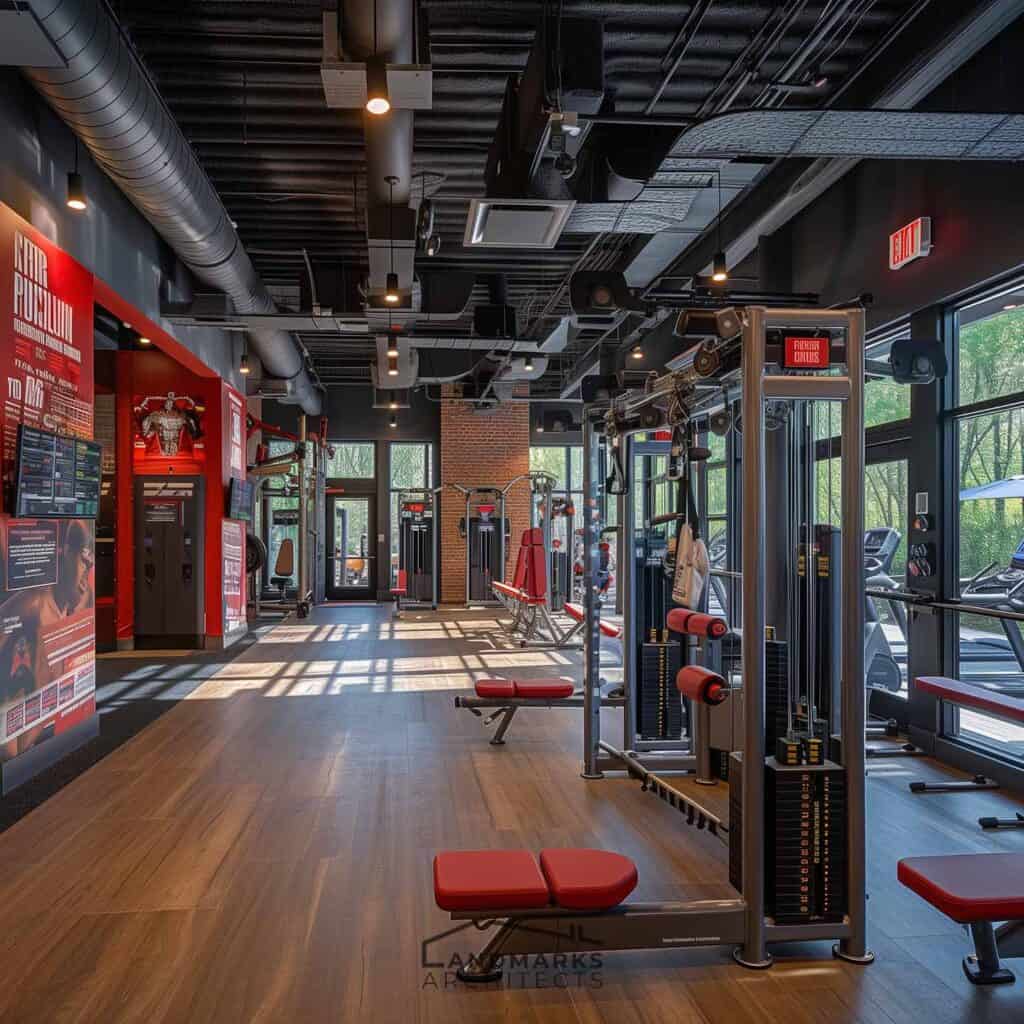
Motivational design elements such as inspirational quotes, wall graphics, and digital displays further enhance the user experience, transforming the sports area into a source of inspiration and empowerment. By creating environments that celebrate progress and encourage perseverance, gyms inspire users to push their limits and unlock their full potential.
Group Exercise Studios
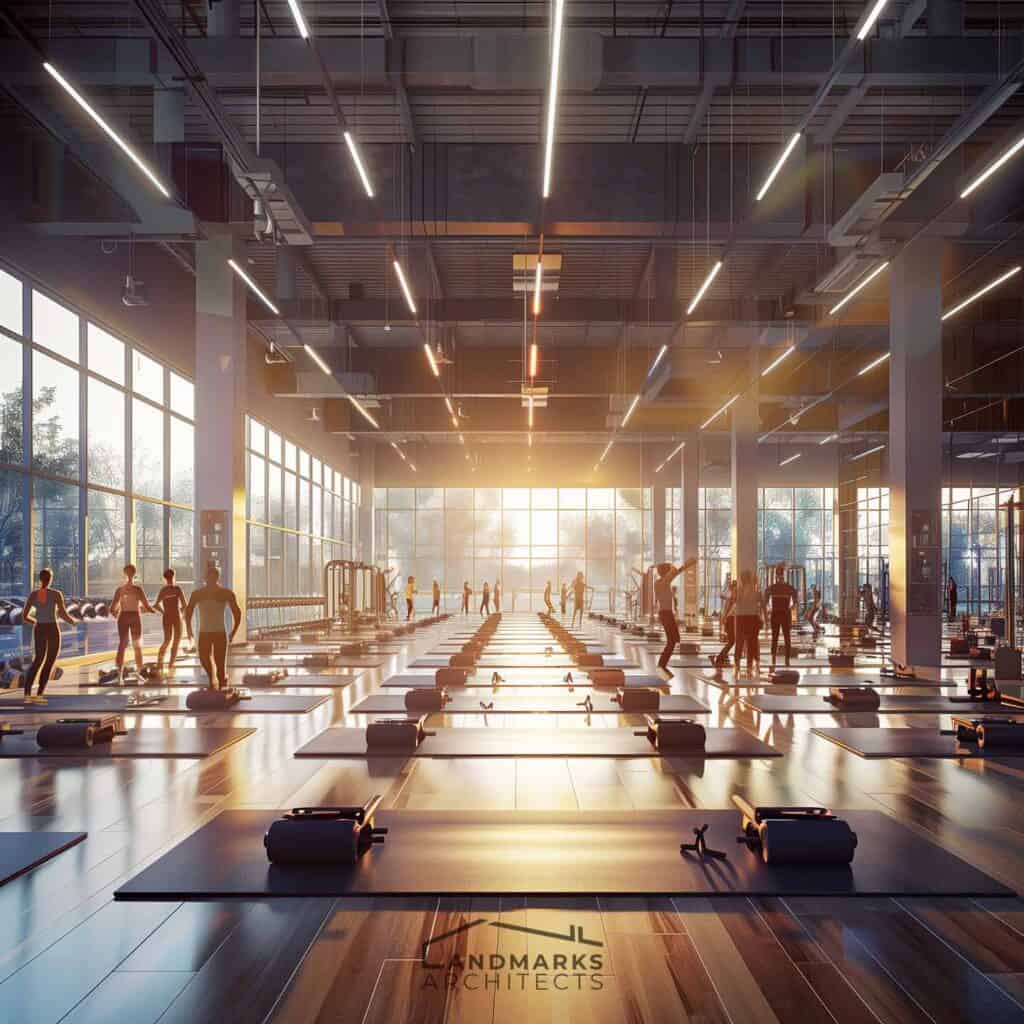
Group exercise studios offer dynamic spaces for communal workouts, fostering a sense of camaraderie and motivation among participants. Versatile design solutions, such as movable partitions and adjustable flooring, enable studios to accommodate a wide range of classes and activities, from high-intensity interval training to mind-body disciplines like yoga and Pilates.
Lighting and sound systems play crucial roles in creating engaging environments that energize and inspire participants. Dynamic lighting schemes and programmable LED fixtures set the mood for each class, while state-of-the-art sound systems deliver crystal-clear audio that amplifies the instructor’s voice and enhances the music experience.
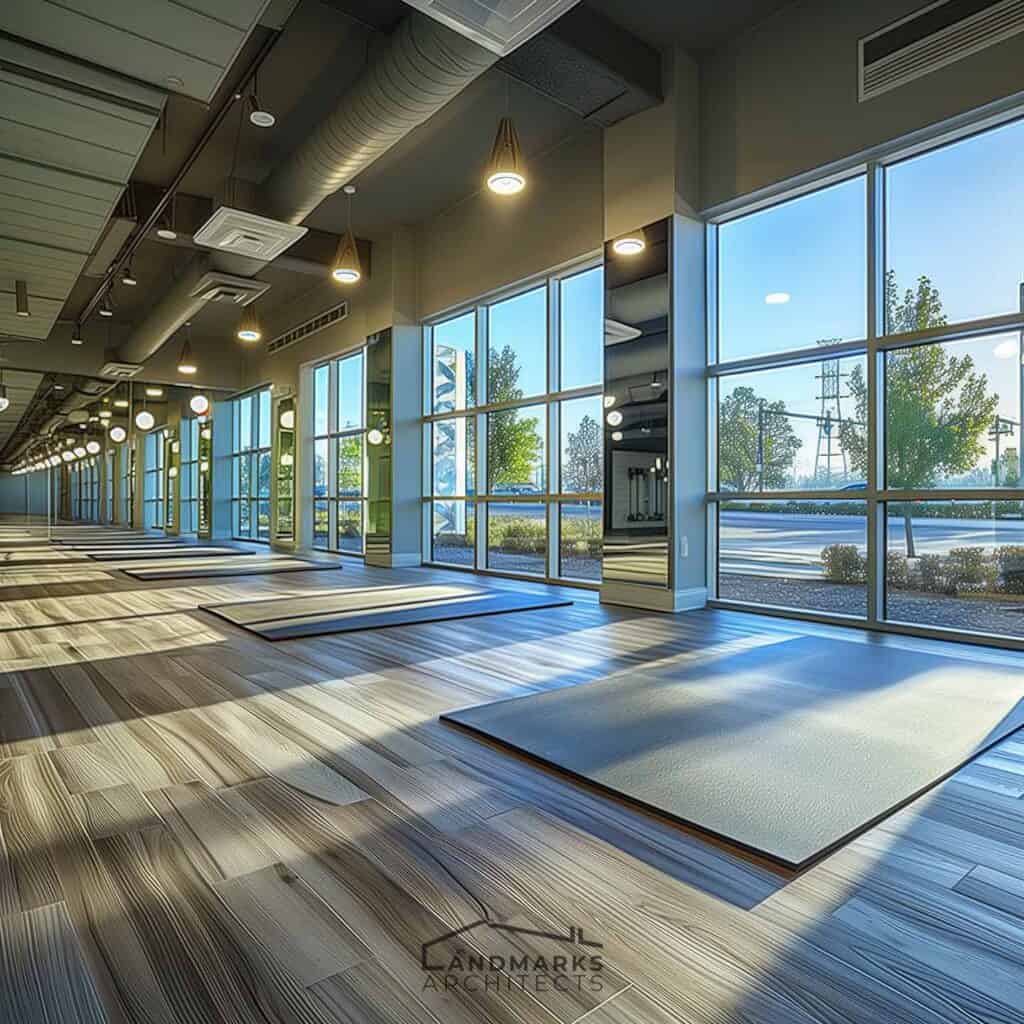
Strategic placement of mirrors and advanced ventilation systems enhance the experience of group fitness classes in studios. Mirrors allow participants to monitor their form and technique, fostering a supportive environment for improvement. Additionally, efficient ventilation systems ensure optimal air quality and temperature, promoting focus, endurance, and overall enjoyment throughout the workout sessions.
Locker Rooms and Changing Areas
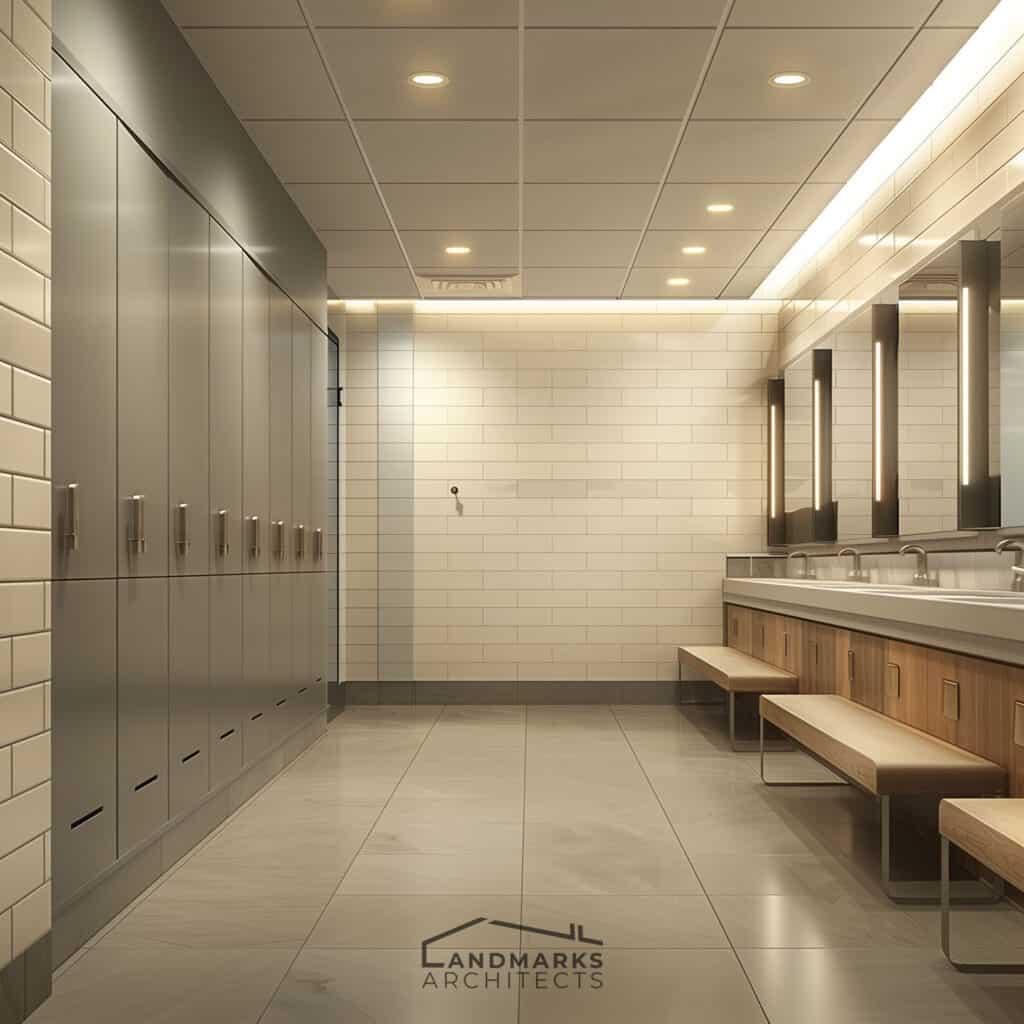
Locker rooms and changing areas are vital components of any gym facility, offering users a space to prepare for and wind down after their workouts. These areas are meticulously designed to prioritize comfort, convenience, and hygiene, providing users with amenities to enhance their overall experience. Spacious lockers offer secure storage for personal belongings, while ample seating and grooming stations ensure users can freshen up with ease.
Luxurious finishes, such as sleek tiling and upscale countertops, create a sense of elegance and sophistication. Additionally, well-appointed shower facilities equipped with modern fixtures and amenities provide users with a rejuvenating post-workout experience. With attention to detail and user-centric design, locker rooms and changing areas contribute to the overall ambiance and functionality of the gym, ensuring that users feel pampered and well-cared-for throughout their visit.
Showers and Bathrooms
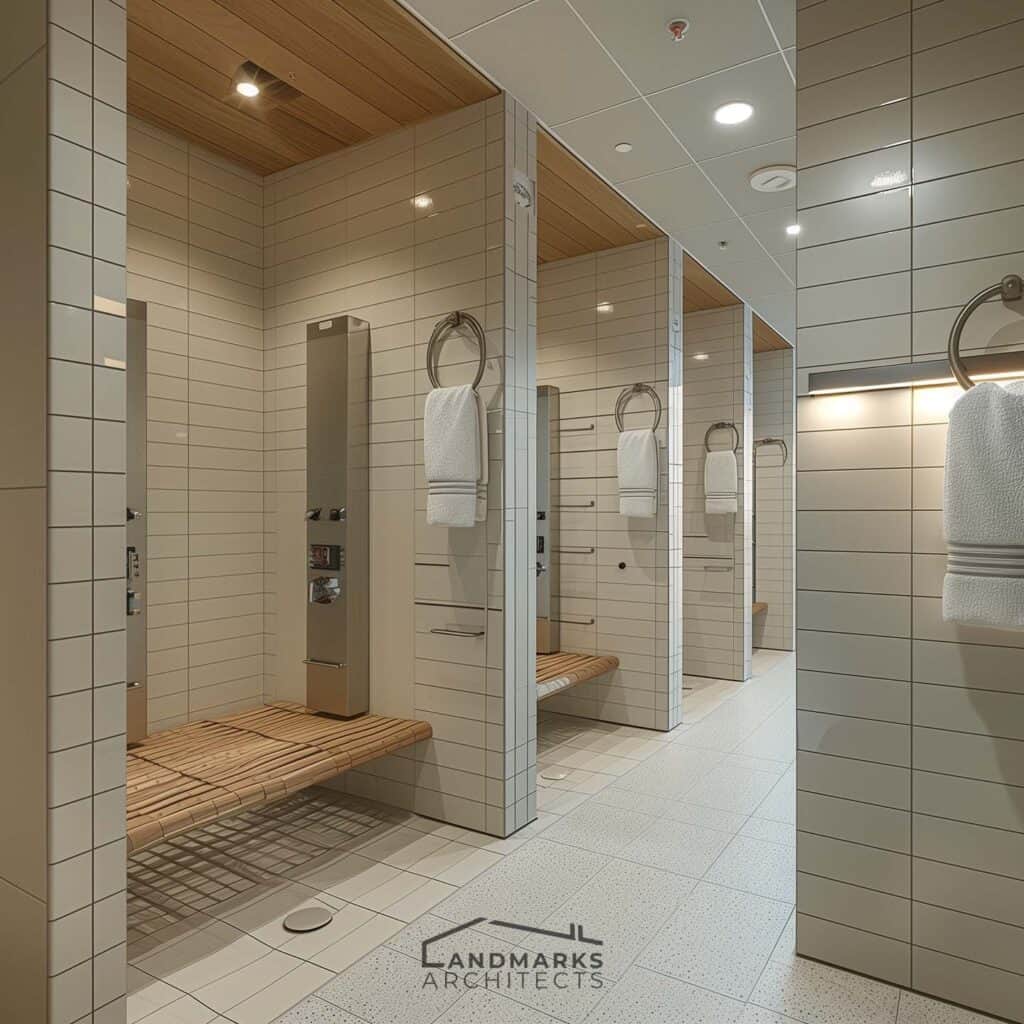
Showers and bathrooms offer opportunities for relaxation and rejuvenation within the gym environment, providing users with spaces to cleanse, refresh, and recharge after their workouts. Thoughtfully designed shower facilities optimize space and functionality, featuring spacious walk-in showers with adjustable water pressure and temperature controls, as well as separate changing areas with ample storage for towels and personal belongings.
Bathroom design considerations prioritize cleanliness, accessibility, and user comfort, ensuring that every aspect of the space is tailored to enhance the user experience. From easy-to-clean surfaces and water-saving fixtures to grab bars and non-slip flooring, every detail is designed with user safety and convenience in mind, creating environments that promote relaxation and rejuvenation.
Incorporation of design elements such as soothing color palettes, natural materials, and soft lighting further enhances the user experience, creating environments that evoke feelings of tranquility and well-being. By prioritizing user comfort and satisfaction, gyms create shower and bathroom facilities that rival those of luxury spas and resorts, offering users an unparalleled experience of relaxation and rejuvenation.
Café or Lounge Area
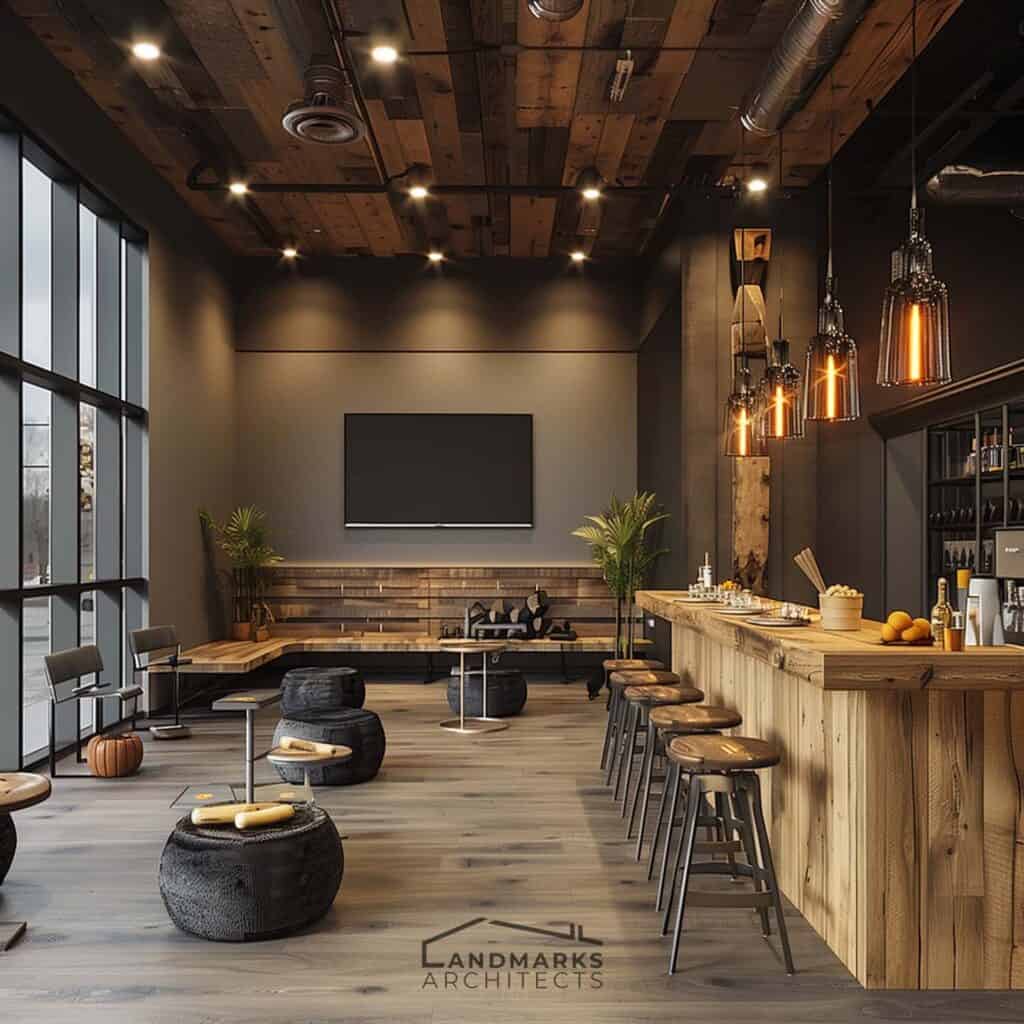
Café or lounge areas within the gym environment provide users with spaces to socialize, relax, and recharge before or after their workouts. Thoughtfully designed layouts optimize space and functionality, featuring comfortable seating arrangements, communal tables, and bar counters where users can enjoy healthy snacks, beverages, and post-workout refreshments.
Design concepts for café or lounge areas focus on creating inviting atmospheres that encourage socialization and relaxation, incorporating elements such as plush seating, soft lighting, and natural materials that evoke feelings of warmth and comfort. From cozy sofas and armchairs to ergonomic barstools and ottomans, every piece of furniture is chosen for its comfort, durability, and aesthetic appeal, creating environments that invite users to linger and unwind.
Outdoor Spaces
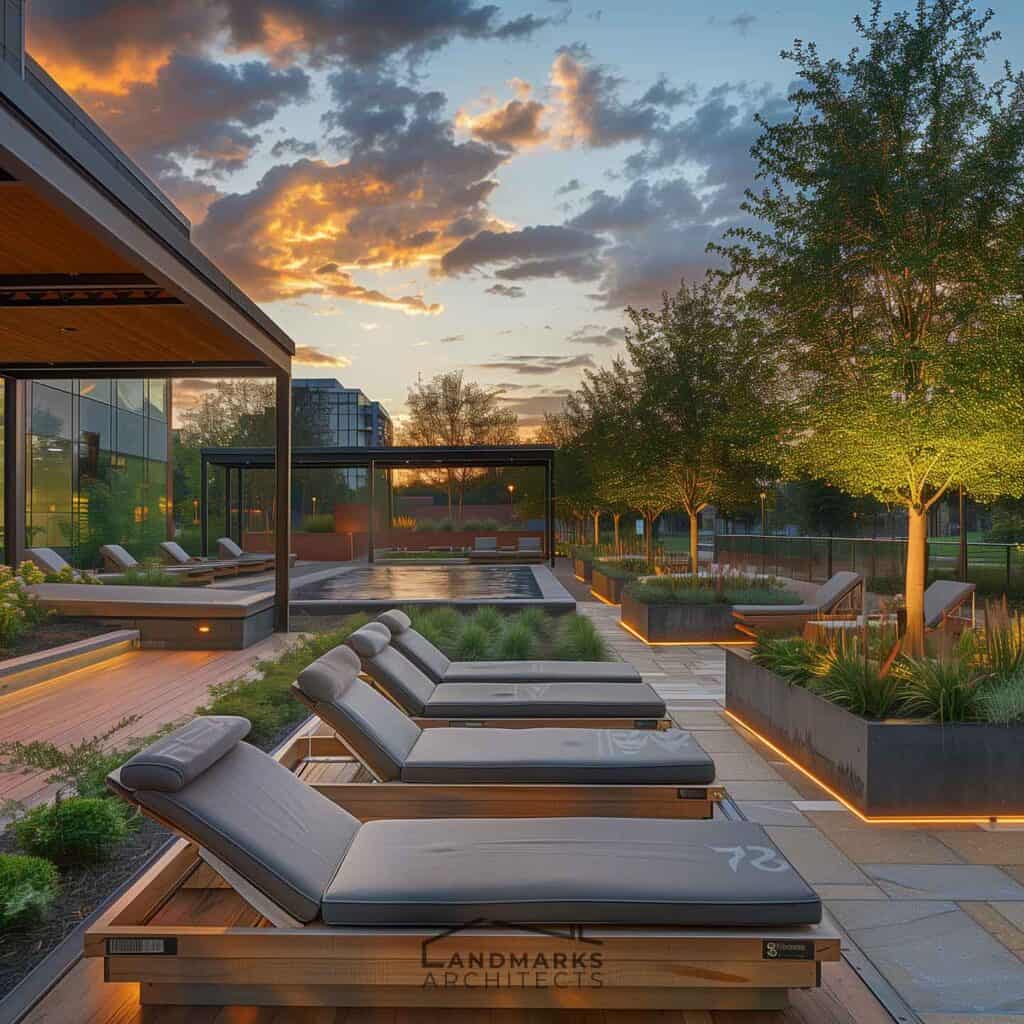
Outdoor spaces within the fitness center environment provide users with opportunities to connect with nature and bask in fresh air and sunlight while exercising. Design concepts for outdoor areas prioritize functionality, creating inviting environments suitable for a variety of activities and preferences. These may include outdoor fitness zones, running tracks, relaxation areas, and rooftop terraces.
Utilization of outdoor areas for additional workout space or recreational activities maximizes the potential of gym environments, offering users a wide range of options for staying active and engaged. Design ideas for outdoor fitness zones may include dedicated areas for cardio, strength training, and functional training, as well as open spaces for group classes, yoga, and meditation.
Weather-resistant materials and landscaping elements such as trees, shrubs, and native plants enhance the outdoor experience, creating environments that blend seamlessly with the surrounding landscape while providing users with opportunities to connect with nature and enjoy the outdoors. From shaded seating areas and pergolas to water features and fire pits, every element is designed to enhance the overall user experience and create inviting, memorable outdoor spaces that inspire and delight.
5. Branding and Identity
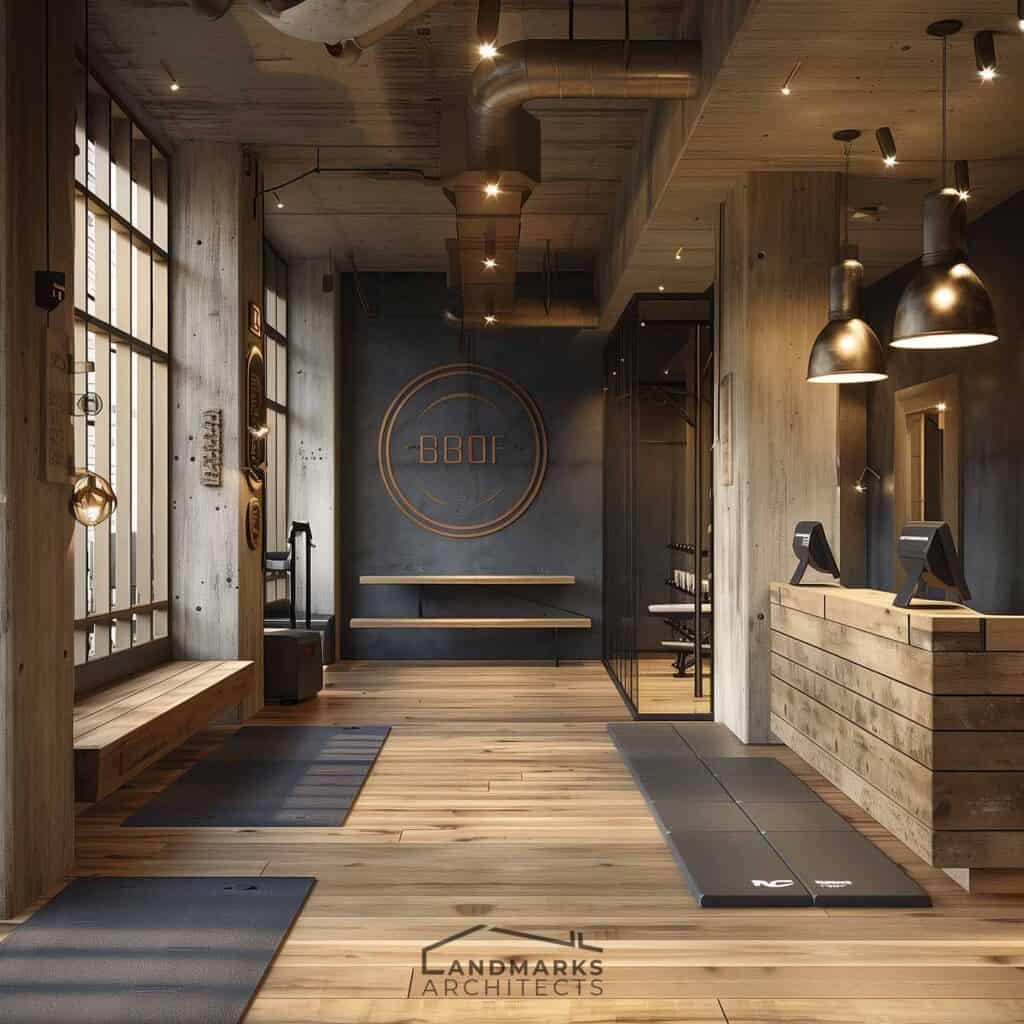
Interior design in boutique fitness studios acts as a potent medium for conveying brand identity and values, fostering experiences that deeply resonate with patrons. From the moment visitors step through the doors, they are enveloped in a world of branding elements that evoke emotions and forge connections.
Logos, colors, and signage serve as visual anchors, reinforcing brand recognition and creating a sense of continuity throughout the space. Every detail, from the font on the reception desk to the pattern on the gym mats, contributes to a cohesive brand narrative that communicates the ethos and personality of the facility.
Beyond aesthetics, branding extends to the overall experience, influencing everything from customer service interactions to class offerings and amenities. By aligning design elements with brand values such as inclusivity, innovation, and community, gyms create environments that not only attract new members but also foster long-lasting relationships built on trust and loyalty.
6. Innovative Features and Technology
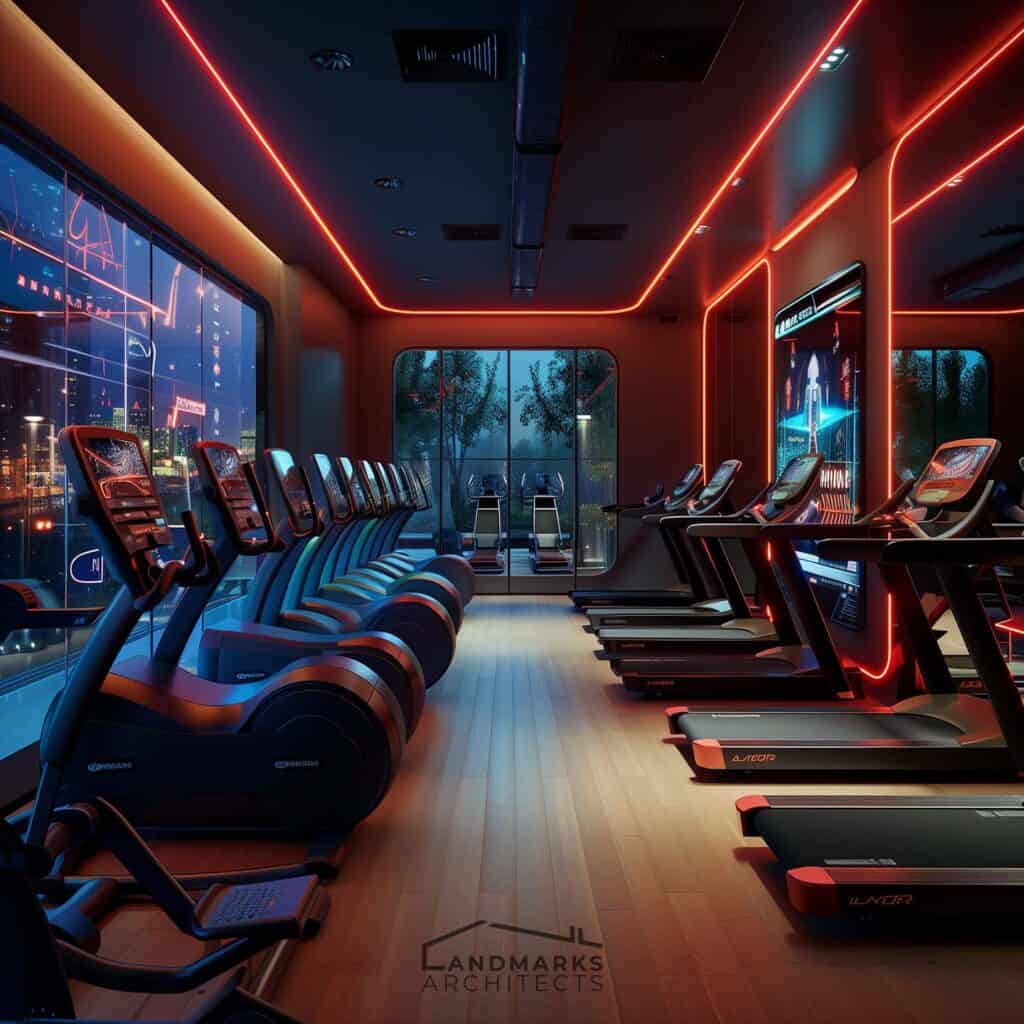
Innovation lies at the center of gym interior design, driving the evolution of fitness spaces towards new frontiers of functionality and engagement. From state-of-the-art equipment to cutting-edge digital technologies, the possibilities are endless, limited only by the imagination.
Smart technology transforms traditional workout equipment into interactive fitness experiences, offering users real-time feedback, personalized workouts, and virtual environments. From touchscreen consoles that track progress and adjust resistance to augmented reality headsets that transport users to exotic locales, these innovative features redefine the boundaries of what’s possible in the gym.
Interactive installations further enhance the user experience, transforming workout spaces into interactive playgrounds where users can explore, play, and connect with others. From interactive climbing walls that challenge strength and agility to motion-activated light displays that respond to movement, these playful elements inject a sense of fun and excitement into workouts, motivating users to push their limits and explore new horizons.
7. Sustainability and Wellness
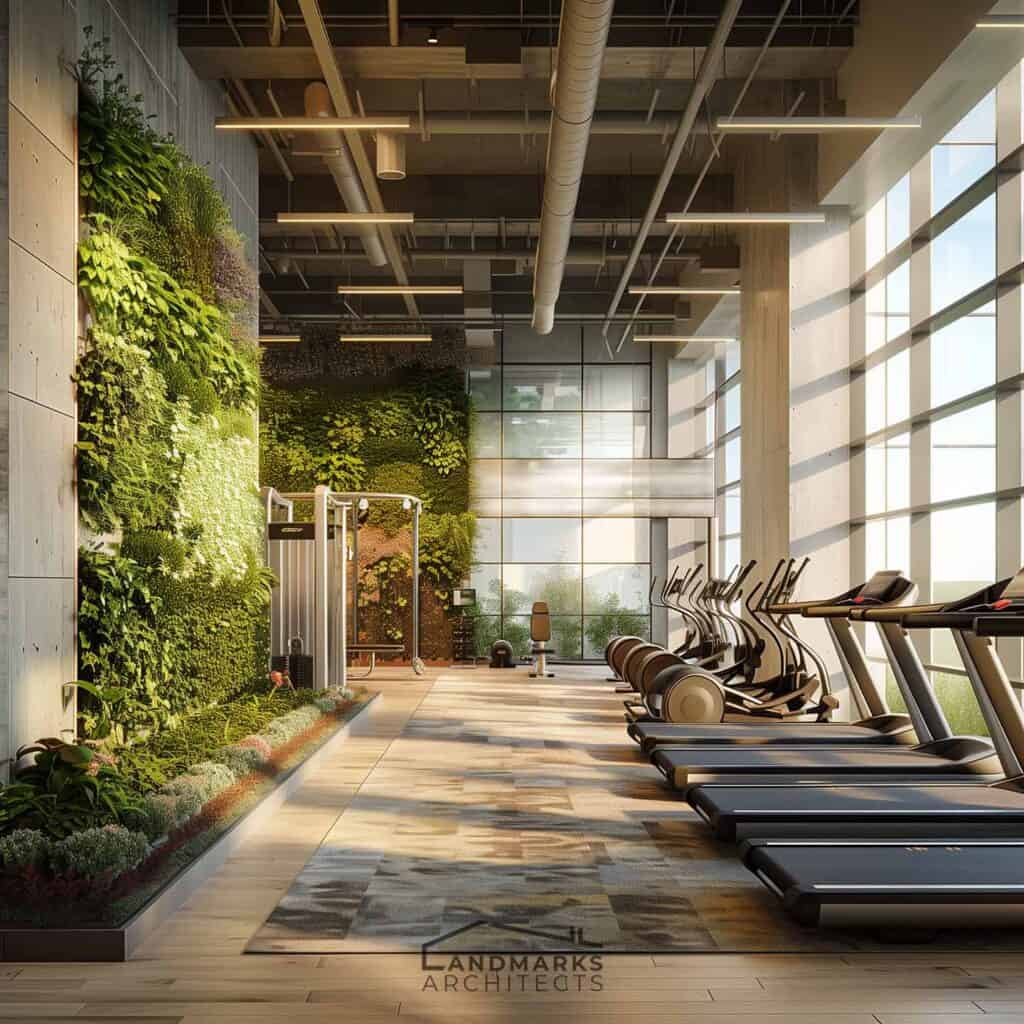
As awareness of environmental and personal well-being grows, so does the emphasis on sustainability and wellness in gym interior design. Eco-friendly materials, energy-efficient systems, and biophilic design elements converge to create environments that not only promote physical health but also nurture a deeper connection with nature.
From recycled rubber flooring to low-VOC paints and finishes, sustainable materials reduce the environmental footprint of gym interiors while creating healthier indoor environments for users. Energy-efficient lighting and HVAC systems, (Heating, ventilation, and Air Conditioning), further minimize resource consumption, ensuring that gyms operate in harmony with the planet.
Biophilic design principles integrate elements of nature into the built environment, fostering a sense of connection and well-being among users. Living walls, indoor gardens, and natural materials evoke the tranquility of the outdoors, creating environments that inspire relaxation and rejuvenation. By prioritizing sustainability and wellness in gym design, facilities not only enhance the health and happiness of their users but also contribute to a more sustainable future for generations to come.
8. Safety and Accessibility
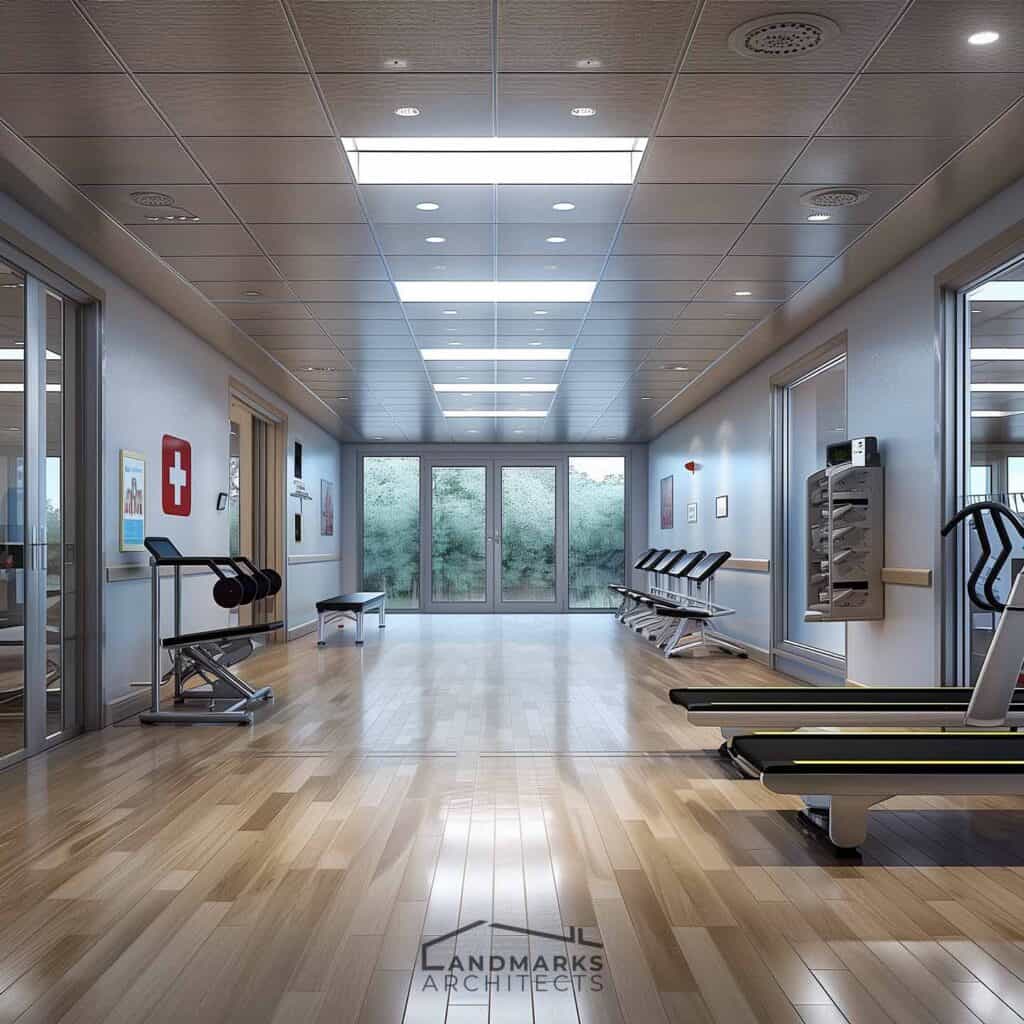
Safety and accessibility considerations are paramount in gym interior design, ensuring that users can enjoy a safe, comfortable, and inclusive fitness experience. Design solutions focus on creating environments that comply with safety regulations and accommodate users with disabilities, while also promoting overall health and well-being.
Integration of emergency exits, first aid stations, and accessible pathways ensures that gyms are equipped to handle emergencies and provide assistance to users in need. Designated emergency exit routes and signage guide users to safety in the event of an evacuation, while first aid stations provide essential medical supplies and equipment for treating injuries and illnesses.
Accessible pathways, ramps, and elevators ensure that users with disabilities can navigate the gym environment safely and independently, while also promoting inclusivity and equal access for all users. Thoughtfully designed layouts and amenities prioritize user comfort and convenience, ensuring that every aspect of the gym experience is accessible and enjoyable for users of all ages, abilities, and backgrounds.
Gym Interior Design Concept: A Recap
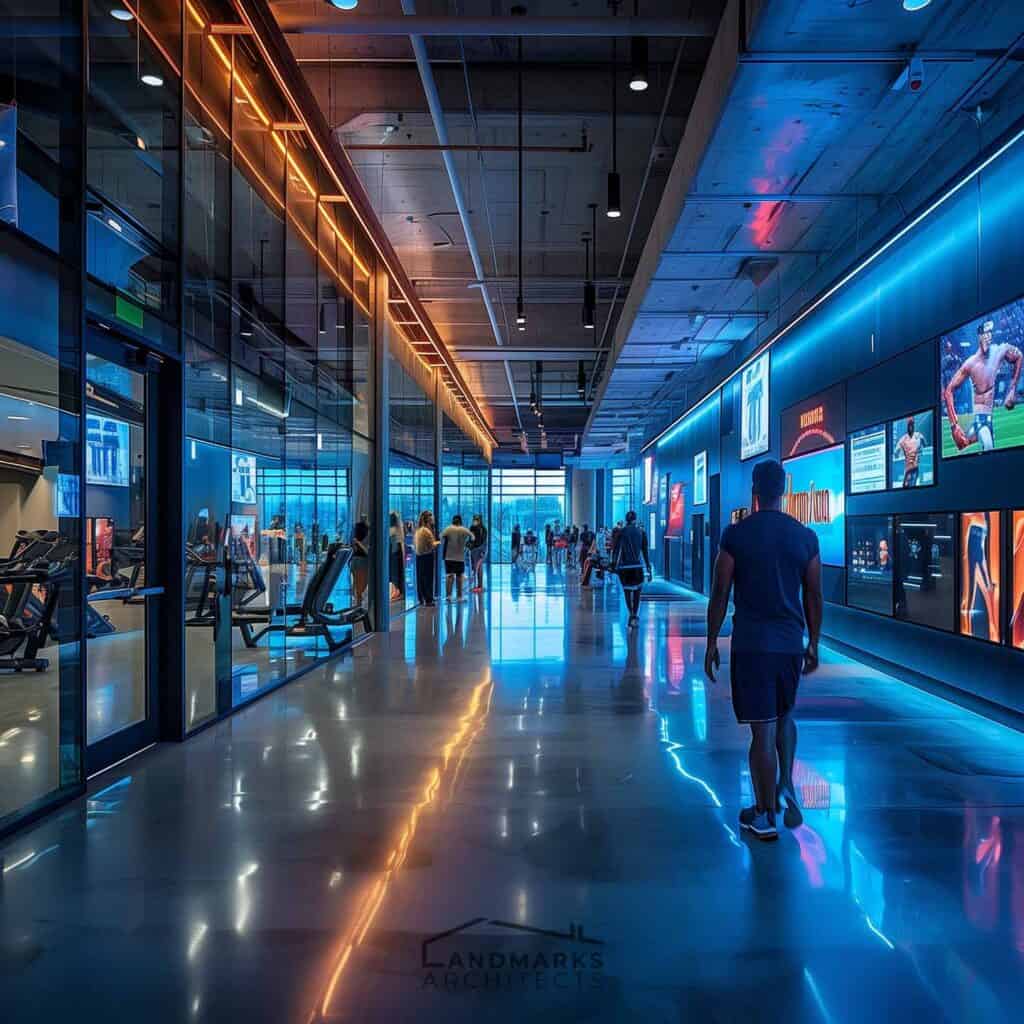
In conclusion, the fitness center design concept encapsulates a myriad of ideas, trends, and concepts that elevate fitness spaces to unprecedented levels of functionality, aesthetics, and engagement. From pioneering technologies to eco-conscious practices, every facet of fitness center design is carefully orchestrated to enrich the user experience and foster holistic well-being.
As gym owners and designers continue to push the boundaries of innovation and creativity, they have the opportunity to create environments that inspire, motivate, and empower users on their fitness paths. By prioritizing functionality, aesthetics, and inclusivity in gym interior design, facilities can create spaces that not only attract and retain members but also foster a sense of community, connection, and belonging that transcends the physical boundaries of the gym.










